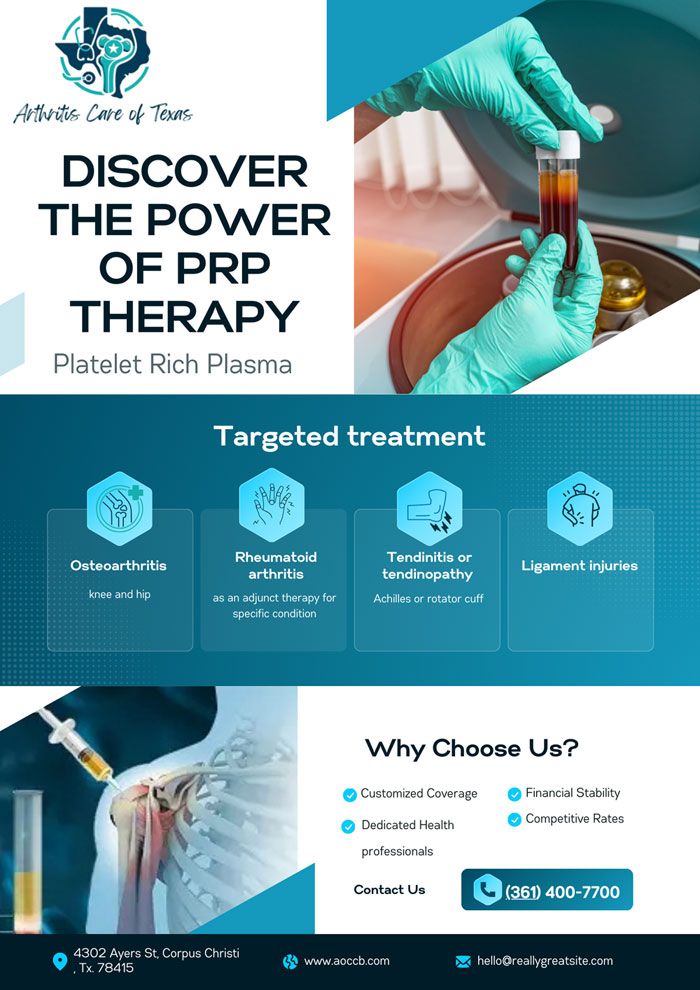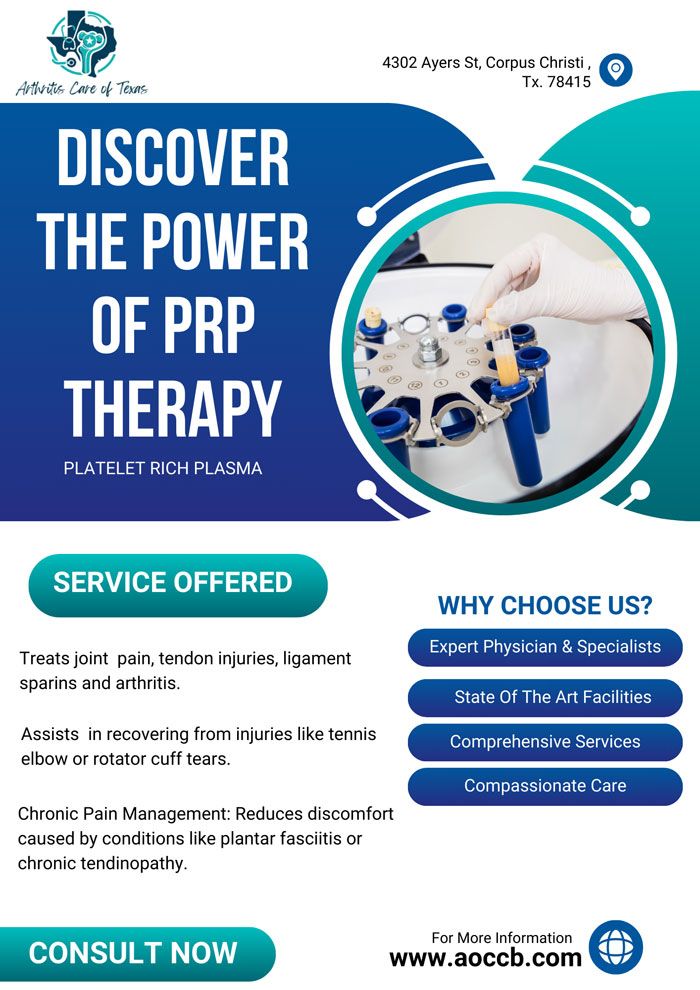Platelet Rich Plasma Therapy (PRP)

Platelet Rich Plasma therapy (PRP) is a ground breaking non-operative treatment option that relieves pain by naturally promoting long lasting healing of musculoskeletal conditions. The acronym PRP has most recently been featured in the news with the rising popularity of the treatment among professional athletes, recreational athletes, and highly functional individuals. Many have attributed PRP injections, particularly for athletic injuries, with enabling them to return back to regular activities and competition with minimal to no pain at all. This rapidly emerging technique shows very promising potential for many conditions such as arthritis, tendonitis, and ligament sprains and tears.
PRP therapy presents patients with a long lasting, permanent solution through the body’s natural healing process. PRP is not something that wears off over time as with a traditional pain injection.
WHAT IS PRP (PLATELET RICH PLASMA)?
Platelet rich plasma, commonly referred to as “PRP”, is human blood that is spun down and separated producing a concentration of platelets above normal values. Platelets are the clotting cells of our blood, but they also have great potential in enhancing healing of muscle, tendon, and ligaments. Studies suggest that growth factors released by platelets recruit reparative cells, may augment tissue repair, and accelerate soft tissue healing.
PRP has been used in surgery to augment shoulder rotator cuff and Achilles tendon repair. PRP has also shown great promise when injected into chronically injured tendons and when proper healing has not taken place. Many clinical trials are underway to determine the full spectrum of use for PRP. In a spine practice, clinicians have anecdotally noted promising results when PRP is injected into spinal ligaments, into facet joints, and/or intervertebral discs when other traditional treatments have failed.
THE SCIENCE OF PRP:
Our blood is made up of 93% red blood cells, 6% white blood cells, 1% platelets and plasma. Platelets are best known for their function of blood-clotting to stop bleeding. Platelets, however, are much more significant than this, as human platelets are also a critical component in injury healing.
Platelets are naturally extremely rich in the connective tissue growth and healing factors. The body’s first response to tissue injury is to deliver platelets to the area. Platelets initiate repair and attract stem cells to the injury. Injecting these growth factors into damaged ligaments, tendons, and joints stimulates the natural repair process. In order to maximize the healing process, the platelets must be concentrated and separated from the red blood cells. The goal of PRP is to maximize the number of platelets while minimizing the number of red blood cells in a solution that is injected into the injured or pained area(s). In summary, PRP creates, stimulates, and accelerates the body’s natural healing process.
WHICH CONDITIONS BENEFIT MOST FROM PRP?
PRP treatment works most effectively for chronic ligament and tendon sprains/strains that have failed other conservative treatment, including but not limited to:
- Rotator cuff injuries, including partial-thickness
- Shoulder pain and instability
- Tennis and golfer’s elbow
- Hamstring and hip strains
- Knee sprains and instability
- Patellofemoral syndrome and patellar tendonitis
- Ankle sprains
- Achilles tendonitis & plantar fasciitis
- Knee, hip, and other joint osteoarthritis
- Nerve entrapment syndromes, such as Carpal Tunnel Syndrome
- Sacroiliac (SI) joint dysfunction and pain
Additionally, PRP can be effective for many cases of osteoarthritis by stimulating healing of cartilage and reducing pain and disability. This includes:
- Knee arthritis
- Hip joint arthritis
- Shoulder arthritis
- Ankle arthritis
WILL PRP TREATMENT HELP ME AVOID SURGERY?
With any treatment option the outcome and sustained results are highly dependent on the extent of the injury. For example in the case of mild arthritis, PRP could potentially prevent the development of further degeneration. However, in advanced arthritic degeneration the goal of the treatment is to minimize pain and improve function. PRP (potentially if used in tandem with the use of stem cells) could avoid surgery such as joint replacements and potentially spinal fusion.
HOW IS PRP CREATED?
Creation of PRP is simple, painless, and conveniently done at an office visit. The entire process of drawing blood to solution preparation only takes approximately 25-30 minutes. A small amount of blood is drawn from the patient, just like a routine blood test. Once the blood is drawn it is then placed into a centrifuge. The centrifuge is a machine that spins the blood at high speeds in order to separate the blood into red blood cells and concentrated platelets. Once the blood is separated the red blood cells are discarded, and we are left with concentrated platelet rich plasma (PRP) which is ready to be used in the treatment process.
HOW ARE THE PRP INJECTIONS ADMINISTERED? ARE THE INJECTIONS PAINFUL?
The injection process does not take more than an hour, which includes the creation of the PRP as explained above. The platelet-rich portion is collected and injected back into the injured tendon, ligament, muscle, joint, or disc that has been determined to be a source of pain and is not-healing appropriately. When structures around the spine are being injected, x-ray (i.e. fluoroscopy) guidance is used to assure safe and proper placement of PRP at the affected site. In the extremities, ultrasound-guidance is commonly used to inject PRP into the appropriate tendon, ligament or joint that is being targeted. Injections are performed under image guidance to assure precise placement of PRP. The number of injections varies based on each patient’s individualized condition but typically range anywhere from two to six injections done over time. Patients typically experience significant reduction in pain after the first or second injection.
Generally speaking PRP injections are not painful; however the discomfort level depends on the part of the body being treated. Injections into the joint are of minimal discomfort. There is sometimes a small amount of pain after the procedure; however this does not last more than a few days and can be minimized with over the counter Tylenol. It is critical to avoid anti-inflammatory medications such as Aleve, Motrin, Celebrex, Naprosyn, and Mobic. These drugs may impede the healing process.
WHEN CAN I EXPECT TO FEEL BETTER?
The benefit to PRP therapy is that unlike other treatments it has a sustained outcome and is categorized as a permanent fix. The timeframe for experiencing results is dependent upon the area of injury and the extent of the injury. On average, most patients start to see signs of improvement in the form of reduced pain or increased function within four to six weeks. Continuing a well-designed course of physical therapy and avoidance of aggressive physical activity or overloading the injected tissues is advised in the weeks that follow the injections. This is done to allow the tissues to heal best.
ARE THERE RISKS WITH PRP?
Overall, PRP is an especially safe treatment option with no risk of allergic reaction because it is your own blood. However, anytime a needle is placed in the body, there is a risk of infection, bleeding, and nerve damage. These risks do not happen often, and are very rare. Other risks depend on the area being treated. If you are unsure of the risks of your specific condition, consult your physician.

